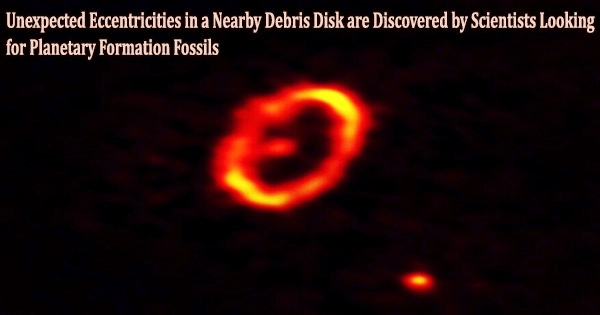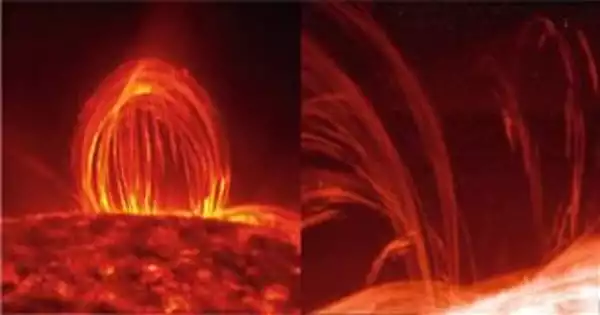Astronomers have observed the debris disk of the neighboring star HD 53143 at millimeter wavelengths for the first time using the Atacama Large Millimeter/submillimeter Array (ALMA), and the results are not what they had anticipated. Planetesimal and dust disks known as debris disks are common around a number of close main sequence stars. As the remains of collisions between planetesimals, also known as asteroids and comets, debris disks can be created and maintained.
The asteroid and Kuiper belts, as well as the dust created by collisions and sublimation of these objects, make up the Solar System’s own debris disk. The zodiacal light is made up of this dust, which is visible from Earth with the naked eye. Debris also collides with the planet, producing meteor showers, extinctions, and maybe much of our water. Scientists anticipated ALMA to confirm the debris disk as a face-on ring dotted with dust clumps based on early coronagraphic evidence.
Instead, a surprising twist in the observations led to the discovery of the most intricate and eccentric debris disk yet to be seen. The observations were presented today in a press conference at the 240th meeting of the American Astronomical Society (AAS) in Pasadena, California, and will be published in an upcoming edition of The Astrophysical Journal Letters (ApJL).
HD 53143 a roughly billion-year-old Sun-like star located 59.8 light-years from Earth in the Carina constellation was first observed with the coronagraphic Advanced Camera for Surveys on the Hubble Space Telescope (HST) in 2006.
Additionally, it is encircled by a debris disk, which is a band of comets orbiting a star that are continually crashing into one another and shattering into smaller particles of dust and debris; this disk is more popularly referred to as the Kuiper Belt.
Debris disks are the fossil record of planet formation, and this new result is confirmation that there is much more to be learned from these systems and that knowledge may provide a glimpse into the complicated dynamics of young star systems similar to our own Solar System.
Meredith MacGregor
The new observations were made of HD 53143 using the highly-sensitive Band 6 receivers on ALMA, an observatory co-operated by the U.S. National Science Foundation’s National Radio Astronomy Observatory (NRAO), and have revealed that the star system’s debris disk is actually highly eccentric.
The star is generally found at or close to the disk’s center in ring-shaped debris disks. However, in elliptically shaped eccentric disks, the star is located at one of the ellipse’s foci, a great distance from the disk’s center.
Such is the case with HD 53143, which wasn’t seen in previous coronagraphic studies because coronagraphs purposely block the light of a star in order to more clearly see nearby objects. The star system may also be harboring a second disk and at least one planet.
“Until now, scientists had never seen a debris disk with such a complicated structure. In addition to being an ellipse with a star at one focus, it also likely has a second inner disk that is misaligned or tilted relative to the outer disk,” said Meredith MacGregor, an assistant professor at the Center for Astrophysics and Space Astronomy (CASA) and Department of Astrophysical and Planetary Sciences (APS) at CU Boulder, and the lead author on the study. “In order to produce this structure, there must be a planet or planets in the system that are gravitationally perturbing the material in the disk.”
This level of eccentricity, MacGregor said, makes HD 53143 the most eccentric debris disk observed to date, being twice as eccentric as the Fomalhaut debris disk, which MacGregor fully imaged at millimeter wavelengths using ALMA in 2017.
“So far, we have not found many disks with a significant eccentricity. In general, we don’t expect disks to be very eccentric unless something, like a planet, is sculpting them and forcing them to be eccentric. Without that force, orbits tend to circularize, like what we see in our own Solar System.”
Importantly, MacGregor notes that debris disks aren’t just collections of dust and rocks in space. They serve as a historical record of the creation of planets and the development of planetary systems across time. and give a glimpse into their upcoming lives.
“We can’t study the formation of Earth and the Solar System directly, but we can study other systems that appear similar to but younger than our own. It’s a bit like looking back in time,” she said. “Debris disks are the fossil record of planet formation, and this new result is confirmation that there is much more to be learned from these systems and that knowledge may provide a glimpse into the complicated dynamics of young star systems similar to our own Solar System.”
Dr. Joe Pesce, NSF program officer for ALMA, added, “We are finding planets everywhere we look, and these fabulous results by ALMA are showing us how planets form both those around other stars and in our own Solar System. This research demonstrates how astronomy works and how progress is made, informing not only what we know about the field but also about ourselves.”
















